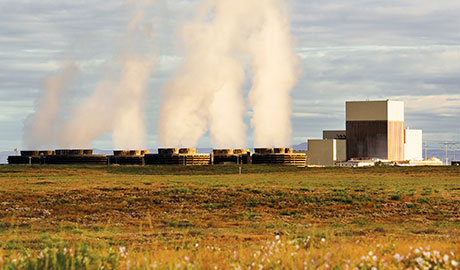BPA exclusively markets the power from the Columbia Generating Station located in southeastern Washington. Owned by Energy Northwest, the nuclear power plant is the third largest energy producer in the Northwest behind Grand Coulee and Chief Joseph dams.
The Bonneville Power Administration has a new tool in its battle against oversupply, and it could help reduce the costs associated with this seasonal power challenge – the nuclear power plant Columbia Generating Station, or CGS.
The plant is operating more flexibly to reduce its generation so that wind and other renewable resources can continue producing power when there’s just too much of it to go around.
“Increased flexibility of CGS’s output during times of high spring runoff is an asset to the region,” says Cherie Sonoda, a BPA supervisory nuclear engineer, who works at the plant. “With lots of research, planning and safety in mind, we worked together to make this happen, and I think it will be a good thing economically for BPA and the region we serve.”
As the winter snow slowly turns to water and rivers rise, so does BPA’s risk of oversupply, or too much power generation, within its system. Each year, when water, wind and other power resources are running at full tilt, power supply can outpace demand. When this occurs, BPA implements its Oversupply Management Protocol to reduce generation, because excess power is bad for grid reliability.
BPA can reduce hydropower output by spilling water rather than sending it through generators when there is no room to store it in reservoirs. But too much spill can negatively affect migrating fish, so BPA then looks to other generators to reduce power output. Through its oversupply protocol, BPA directs other generators, such as wind resources, to shut down to preserve system reliability, and then reimburses them for associated costs.
BPA and Energy Northwest, the owner of CGS, have worked together for years to minimize nuclear generation during times of oversupply. This year, they are working under a new agreement that offers more options for increasing or decreasing CGS’s power generation. Signed in July 2019, the deal improves communications between BPA and Energy Northwest and outlines faster load-shaping capability, plant power levels, recovery times and risks.
“Since BPA receives all of the energy CGS produces, this new agreement and flexibility in CGS operations is a real benefit for the agency,” says Pam Van Calcar, manager of BPA Power Generation Scheduling. “We now have more options in coordination timing and duration of down-powers than we did, making it a little less likely we’ll have to compensate other generators to shut down.”
Under the old agreement, up to several days’ notice was required to decrease power generation at the plant, and then even more time was needed to bring CGS back online. Now, CGS in some cases can decrease generation within two hours’ notice.
The region’s only nuclear power plant, CGS is a 20-minute drive from Tri-Cities, Washington.
Owned by the non-profit Energy Northwest and funded by BPA, the Columbia Generating Station generates up to 1,200 megawatts of energy that is marketed exclusively by BPA.
Operating since 1984, CGS helps BPA serve approximately 140 Northwest public power entities and provides about 13% of the power BPA markets to the region. That makes it the region’s third largest power resource behind Grand Coulee and Chief Joseph dams, producing enough energy for about one million homes, or 4% of the region.
“We would be hard pressed to find another resource right now that is carbon free and provides the amount of power and reliability that the Columbia Generating Station does. Now CGS is significantly increasing the flexibility to respond to a changing system as well,” says Kieran Connolly, vice president of Generation Asset Management for BPA. “It’s a tremendously valuable asset for the Pacific Northwest.”

